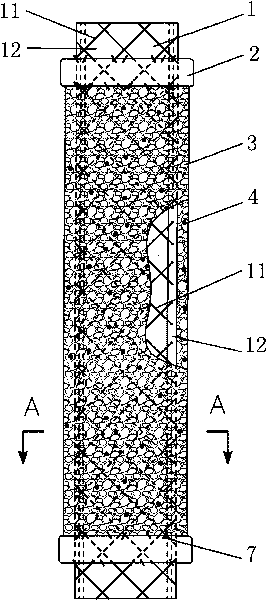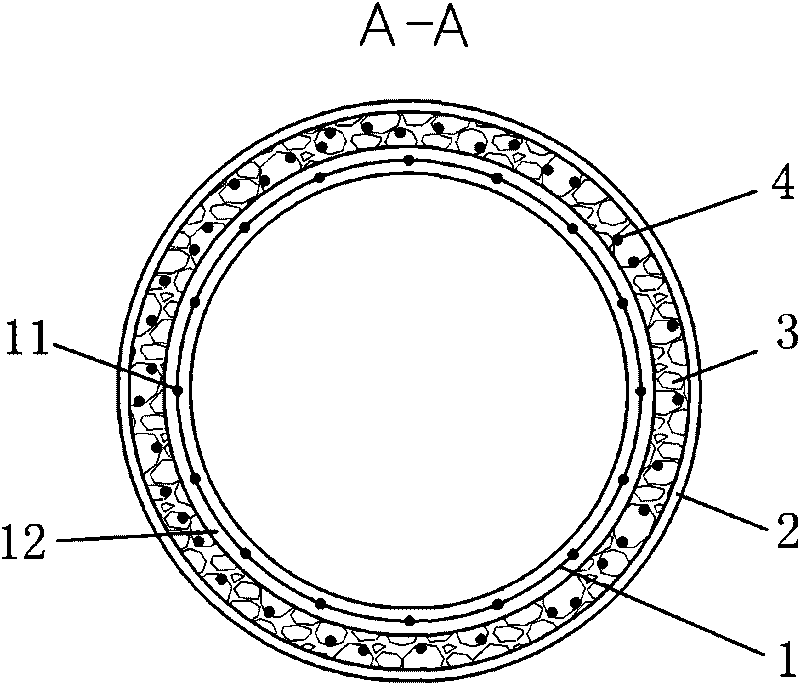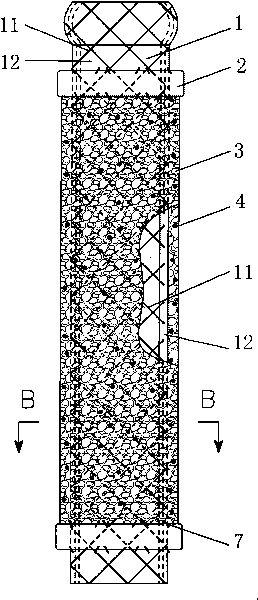Tissue engineering combined human body lumen succedaneum
A tissue engineering and combined technology, applied in the field of human lumen substitutes, can solve the problems of esophageal defect, digestive dysfunction, long time, etc., and achieve the effects of preventing anastomotic leakage, good flexibility, and strong supporting force.
- Summary
- Abstract
- Description
- Claims
- Application Information
AI Technical Summary
Problems solved by technology
Method used
Image
Examples
Embodiment 1
[0084] Embodiment 1: Cross grid type tissue engineering combined human cavity tube substitute of the present invention
[0085] Use nickel-titanium shape memory alloy (Nitinol alloy) wires with a recovery temperature of 15°C and a diameter of 0.25 mm to weave the support frame 11 of the support tube in the mold, and then carry out heat treatment in the mold to make it reticular above the recovery temperature The structure is cylindrical and tubular, and after polishing and cleaning, the support frame 11 of the present invention is obtained.
[0086] In the medical silica gel coating equipment, the support tube 11 is installed in a special mold, and the support frame 11 is coated according to the general process of medical silica gel (if the artificial esophagus with the anti-reflux device is manufactured, the anti-reflux device can also be manufactured at the same time). flow device, refer to Figure 5 ), to get support tube 1.
[0087] A braided polyester ring is used as th...
Embodiment 2
[0095] Embodiment 2: Tissue-engineered combined human cavity tube substitute of the present invention containing polylactide-ethylene glycol-caprolactone copolymer coating of transforming growth factor
[0096] Support tube 1 is prepared according to Example 1.
[0097] A braided polyester ring is used as the connector 2, and the connector 2 is sutured and fixed on the end of the support tube 1 with a surgical suture 7, and the distance from the end is 10 mm. Cleaned, sterilized, and awaiting application of the absorbable coating3.
[0098] Dissolve absorbable biomaterials (such as polylactide-ethylene glycol-caprolactone copolymer) and growth factors (such as transforming growth factor TGFα, PDGF, etc.) in a suitable volatile solvent (such as acetone) to form a suspension Liquid, made into a uniform coating solution with a concentration of 0.01 to 10%, and set aside.
[0099] First, pour the prepared coating solution into the syringe, adjust the power of the ultrasonic gene...
Embodiment 3
[0101] Embodiment 3: The tissue engineered combined type human cavity tube substitute of the present invention containing the polylactide-ethylene glycol copolymer coating of bioglass
[0102] Support tube 1 is prepared according to Example 1.
[0103] A braided polyester ring is used as the connector 2, and the connector 2 is sutured and fixed on the end of the support tube 1 with a surgical suture 7, and the distance from the end is 10 mm. Cleaned, sterilized, and awaiting application of the absorbable coating3.
[0104] Dissolve absorbable biomaterials (such as polylactide-ethylene glycol copolymer) and bioactive glass in a suitable volatile solvent (such as twice distilled water + acetone), and form a suspension or emulsion by ultrasonic dispersion. A uniform coating solution with a concentration of 0.01-10% is prepared for use.
[0105] Inject the coating solution into the ultrasonic atomization spraying device, rotate the support tube body 1 while spraying the liquid c...
PUM
| Property | Measurement | Unit |
|---|---|---|
| thickness | aaaaa | aaaaa |
| thickness | aaaaa | aaaaa |
| thickness | aaaaa | aaaaa |
Abstract
Description
Claims
Application Information
 Login to View More
Login to View More - R&D
- Intellectual Property
- Life Sciences
- Materials
- Tech Scout
- Unparalleled Data Quality
- Higher Quality Content
- 60% Fewer Hallucinations
Browse by: Latest US Patents, China's latest patents, Technical Efficacy Thesaurus, Application Domain, Technology Topic, Popular Technical Reports.
© 2025 PatSnap. All rights reserved.Legal|Privacy policy|Modern Slavery Act Transparency Statement|Sitemap|About US| Contact US: help@patsnap.com



